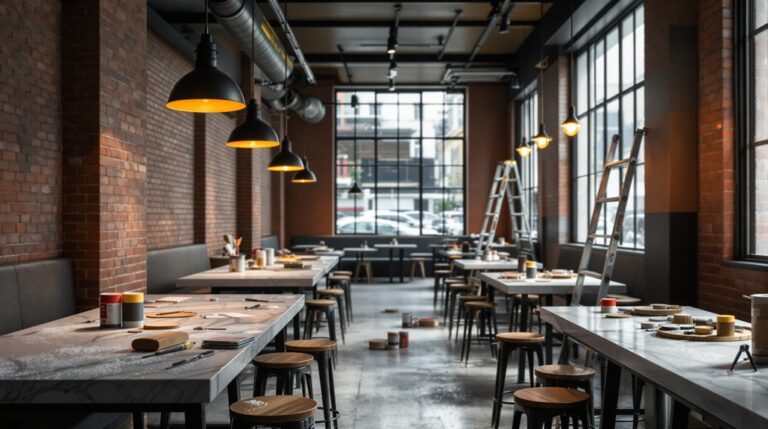Restaurant Remodeling Tips for Success in San Diego County
You’ll need to contact San Diego’s Development Services Department early to obtain permits for electrical, plumbing, and structural changes, as health department approvals typically take 4-8 weeks. Maximize your outdoor dining potential with retractable awnings, windbreaks, and portable heaters to capitalize on San Diego’s year-round weather. Select durable materials for coastal conditions, allocate 20% contingency funds, and design efficient kitchen workflows with clear pathways between the prep and cooking stations. These foundational strategies will set you up for thorough renovation success.
Key Takeaways
- Contact San Diego’s Development Services Department early and schedule pre-application meetings to clarify permit requirements and avoid costly delays.
- Maximize outdoor dining profitability year-round with retractable awnings, windbreaks, portable heaters, and flexible modular seating arrangements.
- Design a kitchen workflow with clear pathways between prep areas, cooking stations, and service windows to maximize efficiency during peak periods.
- Select durable materials that can withstand the coastal climate conditions and allocate 20% contingency funds for unexpected renovation costs.
- Create Instagram-worthy interior moments with strategic lighting that transitions from bright lunch settings to intimate dinner ambiance.
Understanding San Diego's Building Codes and Permit Requirements
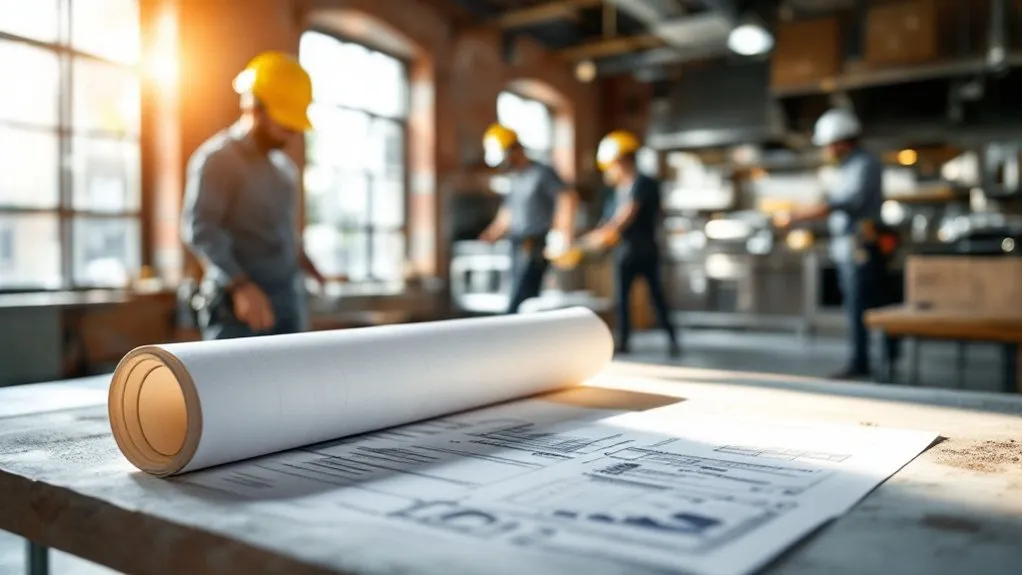
Before you start tearing down walls or installing new kitchen equipment, you’ll need to navigate San Diego’s extensive building codes and secure the proper permits.
Contact the City of San Diego’s Development Services Department early in your planning process. You’ll likely need permits for electrical, plumbing, and structural changes.
Commercial kitchen renovations require special attention to fire suppression systems, ventilation, and ADA compliance. Schedule pre-application meetings to clarify requirements and avoid costly delays.
Don’t forget health department approvals for food service areas. Factor permit processing time into your timeline—it’s typically 4-8 weeks, depending on project complexity.
Maximizing Outdoor Dining Spaces for Year-Round Appeal
Once you’ve secured your permits and approvals, turn your attention to San Diego’s greatest asset—the beautiful weather that makes outdoor dining profitable throughout the year.
Smart design choices will transform your patio into a revenue-generating powerhouse.
Essential elements for year-round outdoor dining success:
- Install retractable awnings or pergolas – Shield guests from intense sun while maintaining the open-air experience they crave.
- Add strategic windbreaks – Glass panels or decorative screens protect diners without sacrificing atmosphere.
- Incorporate portable heaters – Extend profitable evening service during cooler months.
- Design flexible seating arrangements – Modular furniture adapts to different group sizes and weather conditions.
Creating Brand-Aligned Interior Design That Stands Out
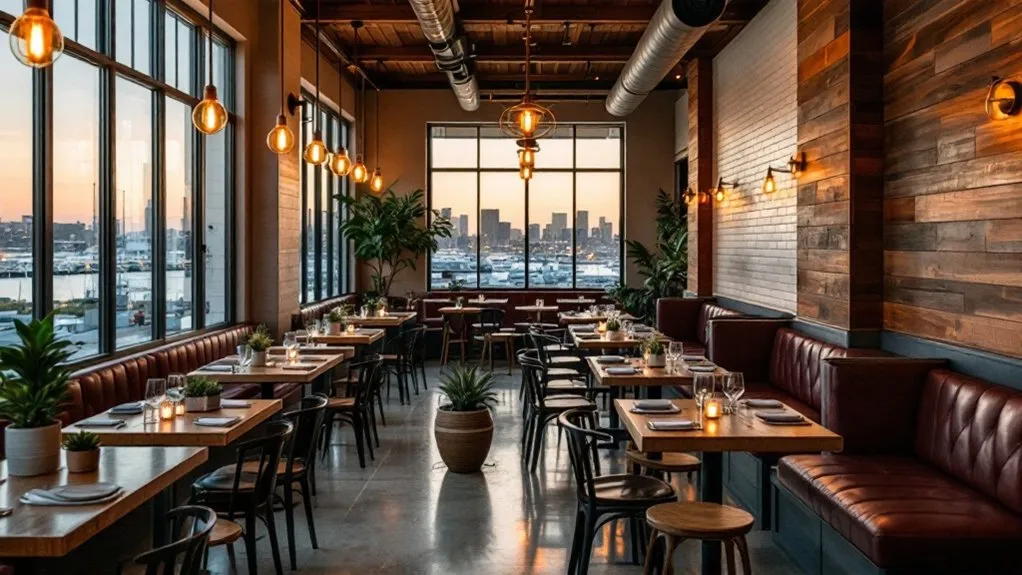
While outdoor spaces draw customers in, your interior design determines whether they’ll become loyal patrons who return again and again.
Your restaurant’s interior should reflect your brand’s personality through strategic color schemes, lighting, and furnishings. Consider your target demographic when selecting materials and décor elements. Bold accent walls can create Instagram-worthy moments that generate social media buzz.
Don’t overlook acoustics—proper sound control guarantees comfortable conversations. Mix textures and patterns to add visual interest without overwhelming guests.
Strategic lighting shifts from bright lunch settings to intimate dinner ambiance. Remember, cohesive design elements throughout your space reinforce brand recognition and create memorable dining experiences.
Optimizing Kitchen Layout and Workflow Efficiency
Behind every successful restaurant lies a meticulously planned kitchen that operates like a well-oiled machine.
When you’re remodeling, prioritize workflow efficiency to maximize your team’s potential and minimize stress during rush periods.
Your kitchen’s layout has a direct impact on service speed, food quality, and staff morale.
Consider these essential elements:
- Create clear pathways between prep areas, cooking stations, and service windows to prevent dangerous collisions.
- Position equipment strategically so your chefs can move seamlessly from refrigeration to prep to cooking.
- Install adequate ventilation systems to maintain comfortable working temperatures and air quality.
- Design sufficient storage solutions within arm’s reach of each workstation.
Choosing Durable Materials for Coastal Climate Conditions
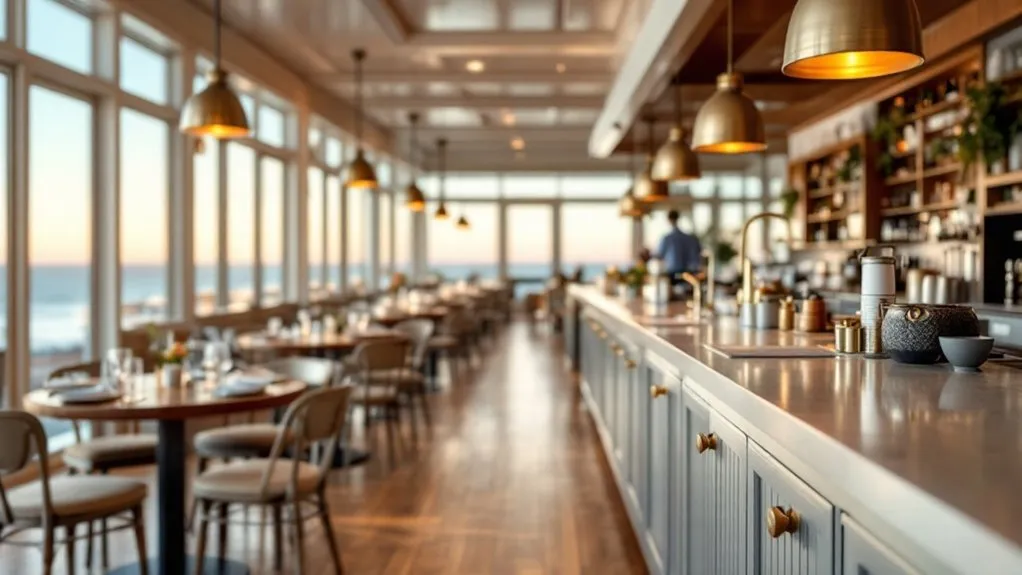
Coastal restaurants face unique environmental challenges that can quickly deteriorate poorly chosen materials, leading to costly repairs. Salt air, humidity, and temperature fluctuations demand strategic material selection for your San Diego County restaurant remodel.
| Material Type | Recommended Options | Benefits |
|---|---|---|
| Flooring | Polished concrete, luxury vinyl | Water-resistant, low maintenance |
| Countertops | Quartz, stainless steel | Non-porous, corrosion-resistant |
| Cabinetry | Marine-grade plywood, aluminum | Moisture-resistant, won’t warp |
| Hardware | Stainless steel, brass | Corrosion-resistant finishes |
Prioritize materials with protective coatings and sealed surfaces to prevent damage. You’ll minimize replacement costs while maintaining your restaurant’s aesthetic appeal, even in harsh coastal conditions.
Budgeting Strategies for Restaurant Renovation Projects
Before selecting your first material sample, establishing a thorough budget framework will help determine the scope and success of your renovation.
You’ll need to account for unexpected costs that inevitably arise during restaurant renovations.
Smart budgeting strategies include:
- Set aside 20% contingency funds – Hidden plumbing issues or structural surprises won’t derail your dreams.
- Prioritize revenue-generating areas first – Your dining room and kitchen have a direct impact on customer experience and profits.
- Get multiple contractor bids – Competition drives down costs while ensuring quality workmanship.
- Phase renovations strategically – Stay operational during updates to maintain cash flow and customer relationships.
Enhancing Customer Experience Through Strategic Space Planning
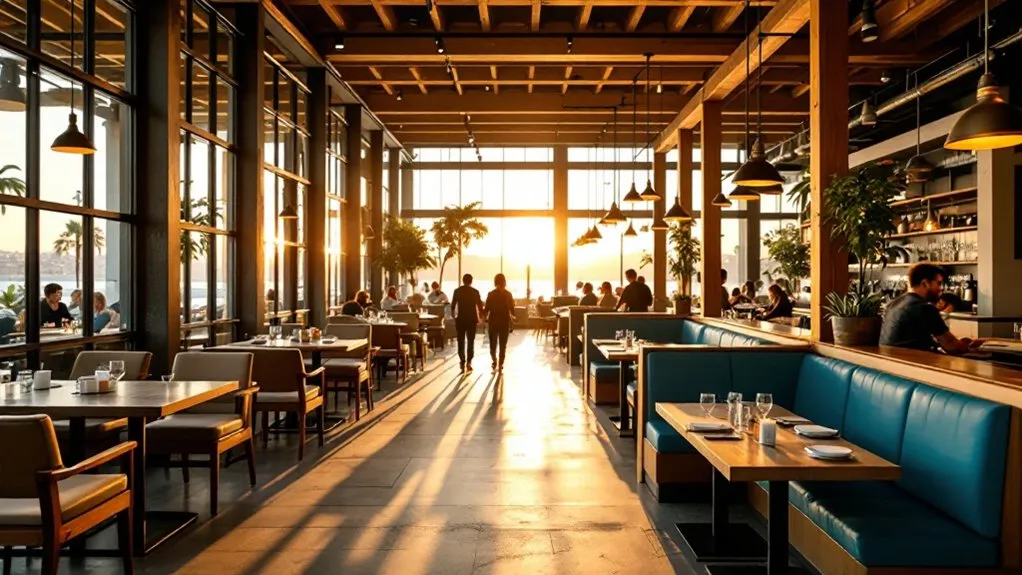
Once your renovation budget is secured, thoughtful space planning becomes your most powerful tool for creating memorable dining experiences.
You’ll want to prioritize traffic flow by creating clear pathways between tables, the kitchen, and the restrooms. Consider your target demographic when designing seating arrangements—opt for intimate booths for couples, communal tables for groups, or bar seating for solo diners.
Don’t overlook acoustics; strategically placing sound-absorbing materials prevents overwhelming noise levels. Position your host station to provide the best guest greeting while maintaining clear sightlines throughout the dining room.
Frequently Asked Questions
How Long Does a Typical Restaurant Remodeling Project Take in San Diego?
A typical restaurant remodeling project in San Diego takes 6-12 weeks, depending on your scope of work.
You’ll spend 2-3 weeks planning and obtaining permits, followed by 4-9 weeks of actual construction.
If you’re doing a complete gut renovation, expect the longer timeline.
Minor updates, such as painting, flooring, and fixtures, can be completed in 4-6 weeks.
You should factor in potential delays from inspections, material delivery issues, or unexpected structural problems that commonly arise during the demolition process.
Do I Need to Close My Restaurant Completely During Renovation?
You don’t necessarily need to close completely during renovation. Many San Diego restaurants remain partially open by renovating in phases, updating one section while continuing to operate in another.
However, if you’re doing major electrical, plumbing, or structural work, a full closure might be required for safety and compliance reasons.
Consider your renovation scope, health department requirements, and whether reduced capacity will generate enough revenue to cover ongoing expenses during construction.
What Are the Best Local Contractors for Restaurant Remodeling Projects?
You’ll want to research contractors who specialize in commercial restaurant work rather than residential projects.
Check their licenses, insurance, and references from other restaurant owners. Look for contractors experienced with health department requirements and ADA compliance.
Obtain multiple detailed bids and verify that they can be completed within your timeline. Ask about their experience with kitchen equipment installation, grease trap systems, and commercial ventilation.
Don’t choose based solely on price.
How Do I Handle Staff and Inventory During the Remodeling Process?
You’ll need to create a detailed timeline for your remodeling project.
Store inventory in a secure off-site location or designate protected areas within your space.
Cross-train staff on temporary procedures and consider offering vacation time during major construction phases.
If you’re doing a partial remodel, section off work areas and maintain clear communication channels.
Don’t forget to update your staff schedule to reflect the reduced capacity and inform employees about the safety protocols in place around construction zones.
What Financing Options Are Available for Restaurant Renovation in San Diego?
You’ll find several financing options for your restaurant renovation.
Consider SBA loans, which offer competitive rates and longer repayment terms. Equipment financing can cover kitchen upgrades, while business lines of credit offer flexible funding options.
Local credit unions often have favorable terms for small businesses. You may also consider exploring investor partnerships or crowdfunding platforms.
Don’t overlook equipment leasing options, which can preserve your cash flow during the renovation period while updating your restaurant’s infrastructure.
Conclusion
You’ve got the blueprint for restaurant remodeling success in San Diego County. Don’t let permits slow you down—start early. Make your outdoor spaces shine year-round by choosing materials that’ll withstand the coastal elements. Your kitchen workflow and brand identity should work together seamlessly. Stick to your budget, plan strategically, and you’ll create a dining experience that keeps customers coming back. Your renovated restaurant will thrive in this competitive market.

